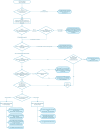Assessment of fall-back MRLs for revoked CXLs previously implemented in the EU legislation and review of the JMPR evaluation of the toxicological data related to pyrasulfotole, pyraziflumid, spiropidion and tetraniliprole
- PMID: 38774114
- PMCID: PMC11106678
- DOI: 10.2903/j.efsa.2024.8693
Assessment of fall-back MRLs for revoked CXLs previously implemented in the EU legislation and review of the JMPR evaluation of the toxicological data related to pyrasulfotole, pyraziflumid, spiropidion and tetraniliprole
Abstract
In accordance with Article 43 of Regulation (EC) 396/2005, EFSA received a request from the European Commission to propose fall-back maximum residue levels (MRLs) for recently revoked Codex MRLs that have been previously implemented in the EU legislation. Overall, MRLs for 12 a.s. are concerned, i.e. chlormequat, diazinon, bifenthrin, fludioxonil, indoxacarb, difenoconazole, famoxadone, azoxystrobin, mandipropamid, emamectin benzoate, flutriafol and afidopyropen. In addition, EFSA was requested to evaluate the toxicological data assessed by JMPR related to pyrasulfotole, pyraziflumid, spiropidion and tetraniliprole. These are active substances have not been assessed previously at EU level. The assessment should allow to take a decision, if the CXLs adopted for these four a.s. can be implemented in the EU MRL legislation.
Keywords: consumer risk assessment; pyrasulfotole; pyrazyflumid; revoked Codex MRLs; spiropidion; tetraniliprole; toxicological evaluation.
© 2024 European Food Safety Authority. EFSA Journal published by Wiley‐VCH GmbH on behalf of European Food Safety Authority.
Conflict of interest statement
If you wish to access the declaration of interests of any expert contributing to an EFSA scientific assessment, please contact interestmanagement@efsa.europa.eu.
Figures
Similar articles
-
Assessment of fall-back MRLs for revoked CXLs previously implemented in the EU legislation.EFSA J. 2025 Mar 10;23(3):e9299. doi: 10.2903/j.efsa.2025.9299. eCollection 2025 Mar. EFSA J. 2025. PMID: 40066208 Free PMC article.
-
Targeted review of maximum residue levels (MRLs) for bifenthrin.EFSA J. 2023 Mar 3;21(3):e07864. doi: 10.2903/j.efsa.2023.7864. eCollection 2023 Mar. EFSA J. 2023. PMID: 36875863 Free PMC article.
-
Targeted review of maximum residue levels (MRLs) for diazinon.EFSA J. 2023 Nov 30;21(11):e08426. doi: 10.2903/j.efsa.2023.8426. eCollection 2023 Nov. EFSA J. 2023. PMID: 38035145 Free PMC article.
-
Targeted review of maximum residue levels (MRLs) for azocyclotin and cyhexatin.EFSA J. 2023 Jun 9;21(6):e08038. doi: 10.2903/j.efsa.2023.8038. eCollection 2023 Jun. EFSA J. 2023. PMID: 37304356 Free PMC article.
-
Targeted review of maximum residue levels (MRLs) for endosulfan.EFSA J. 2023 Jul 27;21(7):e08114. doi: 10.2903/j.efsa.2023.8114. eCollection 2023 Jul. EFSA J. 2023. PMID: 37522102 Free PMC article.
Cited by
-
Modification of the existing maximum residue level for chlormequat in oat.EFSA J. 2025 Apr 28;23(4):e9385. doi: 10.2903/j.efsa.2025.9385. eCollection 2025 Apr. EFSA J. 2025. PMID: 40297192 Free PMC article.
-
Scientific support for preparing an EU position in the 55th Session of the Codex Committee on Pesticide Residues (CCPR).EFSA J. 2024 Jul 18;22(7):e8841. doi: 10.2903/j.efsa.2024.8841. eCollection 2024 Jul. EFSA J. 2024. PMID: 39026987 Free PMC article.
-
Assessment of fall-back MRLs for revoked CXLs previously implemented in the EU legislation.EFSA J. 2025 Mar 10;23(3):e9299. doi: 10.2903/j.efsa.2025.9299. eCollection 2025 Mar. EFSA J. 2025. PMID: 40066208 Free PMC article.
-
Setting of import tolerances for azoxystrobin in melons and watermelons.EFSA J. 2024 Dec 17;22(12):e9130. doi: 10.2903/j.efsa.2024.9130. eCollection 2024 Dec. EFSA J. 2024. PMID: 39691502 Free PMC article.
References
-
- Austria . (2024). Evaluation report prepared under Article 43 of Regulation (EC) No 396/2005. Additional data to be considered to be considered for assessment of fall‐back MRLs for revoked CXLs previously implemented in the EU legislation, 15 January 2024. www.efsa.europa.eu
-
- CCPR (Codex committee on pesticide residues) . (2023). Report of the 54 session of the Codex committee on pesticide residues, Beijing, China, 26 June–1 July 2023.
-
- ECHA and EFSA (European Chemicals Agency and European Food Safety Authority) with the technical support of the Joint Research Centre (JRC) , Andersson, N. , Arena, M. , Auteri, D. , Barmaz, S. , Grignard, E. , Kienzler, A. , Lepper, P. , Lostia, A. M. , Munn, S. , Parra Morte, J. M. , Pellizzato, F. , Tarazona, J. , Terron, A. , & Van der Linden, S. (2018). Guidance for the identification of endocrine disruptors in the context of Regulations (EU) No 528/2012 and (EC) No 1107/2009. EFSA Journal, 16(6), 5311. 10.2903/j.efsa.2018.5311 - DOI - PMC - PubMed
-
- EFSA (European Food Safety Authority) . (2006). Conclusion on the peer review of the pesticide risk assessment of the active substance diazinon. EFSA Scientific Report, 4(8), 85. 10.2903/j.efsa.2006.85r - DOI
-
- EFSA (European Food Safety Authority) . (2009). Conclusion on the peer review of the pesticide risk assessment of the active substance chlormequat (considered variant chlormequat chloride). EFSA Scientific Report, 7(2), 179. 10.2903/j.efsa.2009.179r - DOI
LinkOut - more resources
Full Text Sources


